Dining Room Table
Every year, At Home in Chicago shares a range of stories from its historic house museums, each rooted in a common theme, place, or idea. This year it's all about the dining room table. People may say “If these walls could talk,” but Chicago's historic house museums prove it’s really their tables with fascinating tales to tell.
-
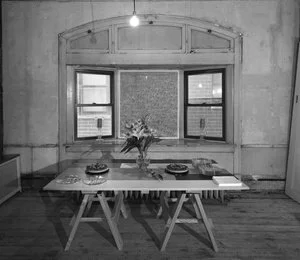
6018North
At this dining room table… contemporary artists engage with the past.
The artist Jane Georges recently installed 2,500 leaves upon dining room walls at 6018North. Unbeknownst to her, 6018North had recently discovered a photograph of its Prairie Style residence's original dining room. The photograph, found in architect Arthur Wolterdorf's files at the Art Institute library, shows the dining room's original wallpaper. The pattern was filled with replicating leaves, bringing an atmosphere of nature inside—just as Georges's does today.
-

Charnley-Persky House Museum
At this dining room table… Sarah Waller got her way.
At the dinner table one evening, Sarah Waller finally told her husband the truth: she was tired of bringing meals up the stairs from the basement kitchen. Maybe the pot roast was especially good that night, because James Waller agreed to an extension of the first floor that included a brand new kitchen just steps away from the dining room. Convenient, yes, but beautiful it was not: the house’s neat symmetry was ruined from 1927 to 1988, when the architecture firm of Skidmore, Owings & Merrill finally removed it.
-
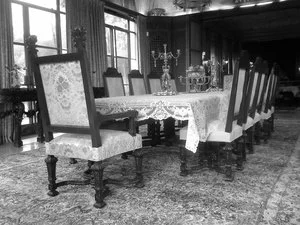
Cuneo Mansion and Gardens
At this dining room table… the hosts were just a century away from texting.
Seated at either end of a formal, 60-person dinner party in 1916, John and Julia Cuneo couldn’t exactly nudge one another under the table when it was time to give a toast or interrupt a conversation gone awry. So, always at the cutting edge of technology, the Cuneos had telephone receivers placed at each end of the extended table so they could converse during dinner. Communication problem: solved.
-
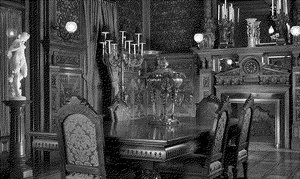
The Diehaus Museum
At this dining room table… the elite of the Guilded Age feasted.
The Driehaus Museum's stunning quarter-sawn white oak dining room table saw many elegant dinners for the Nickerson and Fisher families. The table itself is a work of art and is attributed to Herter Brothers. Today, museum guests will also enjoy an elaborate silver punch bowl by Tiffany & Co. festooned with vine leaves and grapes. The punch bowl was first exhibited at the 1893 Columbian Exposition in Chicago.
-
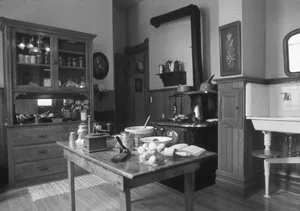
The Ernest Hemingway Birthplace
At this dining room table… a storyteller was born.
At the breakfast table each morning, the Hemingway children waited impatiently as their grandfather finished his food and the morning newspaper. When he was done, Abba—as they affectionately called him—would regale the three young ones with fantastic stories and myths. One morning, Ernest came down to breakfast with an announcement: he had a story to tell this time. Abba, for whom Ernest was named, gladly obliged, and that tale—one of a ship sailing off for faraway adventure—would become the first one this future author put to paper.
-
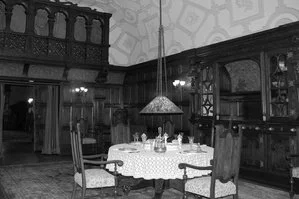
Evanston History Center at the Charles Gates Dawes House
At this dining room table… no one was better than anyone else.
Kings and presidents—as well as ambassadors, a six-star general, Hollywood actors, and extended family members—found themselves on equal footing at this unusual round table. Charles Gates Dawes, U.S. vice president under Calvin Coolidge, preferred a round “non-protocol” table. There was no room for ego, for the host or his guests, at dinner at the Dawes’.
-
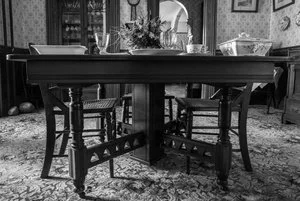
Frances Willard House Museum
At this dining room table… the servants were on their way up the ladder.
The great reformer Frances Willard advocated strongly for the lives of workers, demanding the eight-hour workday, factory inspections, and even unionization for society’s most vulnerable labor force—housemaids, laundry workers, and other domestic servants. As such, when the Willards ate at their dining room table, they were served by immigrants, each of whom the family members educated and helped to assimilate into American society.
-
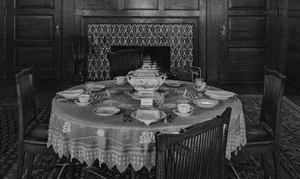
Glessner House
At this dining room table… IQs got a boost.
Prolific writers and art patrons themselves, John and Frances Glessner were well known in the city’s cultural affairs. They stayed active behind the scenes at the Art Institute of Chicago, attended every Chicago Symphony Orchestra performance, and between them were members of no less than five literary clubs. Not surprisingly, often gathered around this table were authors, architects, musicians, and university professors. Their stimulating and enlightened conversation made for a better pairing with the food than wine.
-
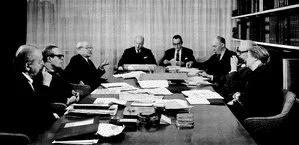
Graham Foundation for Advanced Studies in the Fine Arts
At this dining room table… it all got started.
Charles Murphy, Ernest Graham’s associate and executor, organized a conference at this table in 1955 in Aspen. From these meetings a plan evolved that led to the Graham Foundation. Pictured here at the Graham Foundation’s dining room table is the original advisory board, from left: Ludwig Mies van der Rohe, Jose Luis Sert, Sigfried Giedion, William E. Hartmann, Daniel Catlon Rich, James Johnson Sweeney, John E. Burchard, and Grace L. McCann.
-
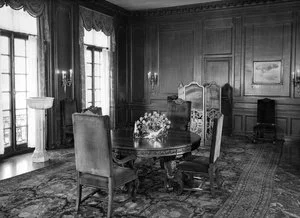
International Museum of Surgical Science
At this dining room table… Chicago’s food magnates would have brought a nice potluck.
The guests sitting around Eleanor Robinson Countiss’s dining room table were often the very industrialists behind the foodstuffs on top of it. The heiress’s guests included Armours and Swifts, heads of a meat-packing empire; the Mortons, for whom Morton Salt is named; the Bordens, of dairy fame; the Schweppes, in the carbonated beverage industry; and the Wrigleys, known for their chewing gum.
-
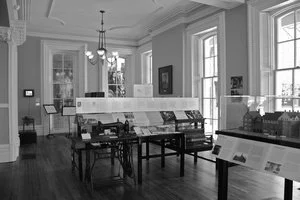
Jane Addams Hull-House Museum
At this dining room table… grand conspiracies were formed.
At the massive tables in the residents’ dining hall at Hull-House, dozens of social reformers met to share meals each day, discuss their work in the neighborhood, and conspire to change the world. Residents were often joined for dinner by leading intellectuals and visionaries, including John Dewey, Ida B. Wells-Barnett, Eleanor Roosevelt, Upton Sinclair, W. E. B. DuBois, and Frank Lloyd Wright.
-
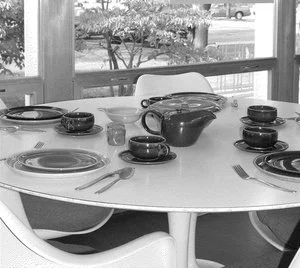
McCormick House at Elmhurst Art Museum
At this dining room table… sits mid-century living.
After the lean war years, industrial manufacturers teamed up with innovative artists to satisfy booming demands for home goods and mounting consumer interest in modern design. No designer was more influential than Russel Wright, whose American Modern line became the single most popular ceramic dinnerware in history. Designed in 1937 and manufactured in Ohio, Wright's beautiful glazed dishes—on view in Elmhurst Art Museum atop the Eero Saarinen tulip table—were available in vibrant colors for consumers to exercise their own tastes by mixing and matching.
-

National Public Housing Museum
At this dining room table… there is diversity.
If you dropped in on the Turovitz family in the Jane Addams Homes in 1938, you’d sample Russian Jewish immigrant cuisine and hear about what an improvement “the projects” were over the Near West Side slums. A few years later, Dianne and Carol Rizzi’s childhood table was piled with candies, pasta, and sauces from nearby Little Italy. The girls lamented their lack of Hostess cupcakes, an American treat their suburban friends enjoyed. If you came to dine with Reverend Marshall Hatch’s family in the same projects in the early 1970s, you’d hear stories of the black church and neighborhood soul music talent shows, and of neighbors rallying to open a public library.
-

Pleasant Home
At this dining room table… the décor was a little shocking.
John Farson treated guests to oysters and other fancy fare at this original table, which was designed by architect George W. Maher to match the carved motifs of the Farson home's interiors. But his successor liked tricks a little better than treats. Local lore has it that the second owner, the inventor Herbert Mills, adorned his table with an electrified tablecloth that sent small shocks to his guests.
-
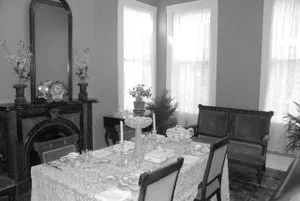
Pullman House Project
At this dining room table… the many stories of pullman come to life.
In the historic Pullman neighborhood of Chicago, the dining room table of Thomas Dunbar's 1900 house showcases a collection of domestic tableware from the period. These practical and decorative relics illuminate the stories of Pullman's workers, the higher-ups, and George Pullman himself.
-
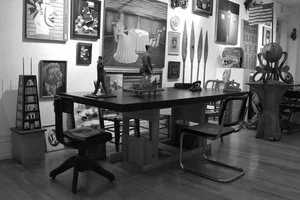
Roger Brown Study Collection
At this dining room table… don’t eat the tramp art.
The artist Roger Brown made his makeshift dining table—brown laminate top, plywood base—into a stage for motley marvels. Instead of lunch, visitors might admire a sporty haberdashery figure, steam irons painted as streamlined vehicles, and chip-carved tramp art. Brown would casually push these objects aside when time to dine with his partner, George Veronda. The two hosted rousing dinner parties for artists, architects, and other friends. Art and life comingled easily at this table
-
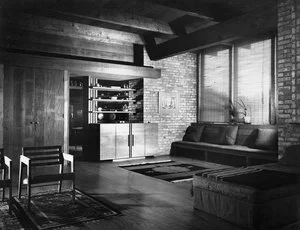
Schweikher House
At this dining room table… was less more, or more less?
Paul and Dorothy Schweikher’s friendship with Mies van der Rohe must have led to many a dinner party debate—perhaps settling once and for all if “more is less” or “less is more.” With that question out of the way, second owners Martyl and Alexander Langsdorf must have spent their evenings getting tips on all the best spots in Stockholm, because more than a dozen Nobel Prize winners were counted among their dinner guests.